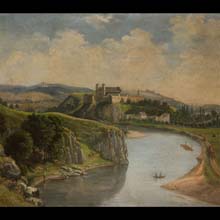
material: oil on cardboard
dimensions: 30,5 x 36 cm
description: The landscape depicts the Benedictine abbey in Tyniec, erected on one of numerous limestone hills in this area. The buildings of the abbey beautifully overlook the Vistula river, and the village nestles at the foot of the monastery hill. In the distance, the Camaldolese priory rises on the Silver Mountain in Bielany. The painting with the genre staffage, adding variety to it, is marked by a muted palette. The Benedictine Abbey in Tyniec was founded in 1044 by Casimir the Restorer, and it served as an important religious and cultural centre for many years. In 1772, it was one of the most important points of resistance of the Bar confederates. After the First Partition of Poland, it was annexed by Austria. In 1816, the Austrian authorities dissolved the monastery and in 1831, the buildings of the abbey were consumed by fire. Consequently, the monastery fell into ruin. By painting the deserted and considerably crumbling monastery in Tyniec, Świerzyński fulfilled the expectations of the art critics of the day encouraging artists to glorify the beauty of the country’s different regions in painting, with special attention paid to the historical and cultural heritage of Poland. Aleksandra Krypczyk
exposition: The Gallery of 19th Century Polish Art in Sukiennice,
The Cloth Hall, 1, Main Market Square
key: Romanticism. Towards national art >>>
dimensions: 30,5 x 36 cm
description: The landscape depicts the Benedictine abbey in Tyniec, erected on one of numerous limestone hills in this area. The buildings of the abbey beautifully overlook the Vistula river, and the village nestles at the foot of the monastery hill. In the distance, the Camaldolese priory rises on the Silver Mountain in Bielany. The painting with the genre staffage, adding variety to it, is marked by a muted palette. The Benedictine Abbey in Tyniec was founded in 1044 by Casimir the Restorer, and it served as an important religious and cultural centre for many years. In 1772, it was one of the most important points of resistance of the Bar confederates. After the First Partition of Poland, it was annexed by Austria. In 1816, the Austrian authorities dissolved the monastery and in 1831, the buildings of the abbey were consumed by fire. Consequently, the monastery fell into ruin. By painting the deserted and considerably crumbling monastery in Tyniec, Świerzyński fulfilled the expectations of the art critics of the day encouraging artists to glorify the beauty of the country’s different regions in painting, with special attention paid to the historical and cultural heritage of Poland. Aleksandra Krypczyk
exposition: The Gallery of 19th Century Polish Art in Sukiennice,
The Cloth Hall, 1, Main Market Square
key: Romanticism. Towards national art >>>












